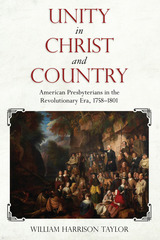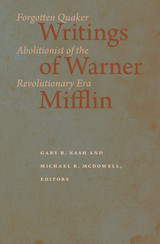2 books about Revolutionary Era

Unity in Christ and Country
American Presbyterians in the Revolutionary Era, 1758–1801
William Harrison Taylor
University of Alabama Press, 2017
Examines the interdenominational pursuits of the American Presbyterian Church from 1758 to 1801
In Unity in Christ and Country: American Presbyterians in the Revolutionary Era, 1758–1801, William Harrison Taylor investigates the American Presbyterian Church’s pursuit of Christian unity and demonstrates how, through this effort, the church helped to shape the issues that gripped the American imagination, including evangelism, the conflict with Great Britain, slavery, nationalism, and sectionalism. When the colonial Presbyterian Church reunited in 1758, a nearly twenty-year schism was brought to an end. To aid in reconciling the factions, church leaders called for Presbyterians to work more closely with other Christian denominations. Their ultimate goal was to heal divisions, not just within their own faith but also within colonial North America as a whole.
Taylor contends that a self-imposed interdenominational transformation began in the American Presbyterian Church upon its reunion in 1758. However, this process was altered by the church’s experience during the American Revolution, which resulted in goals of Christian unity that had both spiritual and national objectives. Nonetheless, by the end of the century, even as the leaders in the Presbyterian Church strove for unity in Christ and country, fissures began to develop in the church that would one day divide it and further the sectional rift that would lead to the Civil War.
Taylor engages a variety of sources, including the published and unpublished works of both the Synods of New York and Philadelphia and the General Assembly of the Presbyterian Church in the United States, as well as numerous published and unpublished Presbyterian sermons, lectures, hymnals, poetry, and letters. Scholars of religious history, particularly those interested in the Reformed tradition, and specifically Presbyterianism, should find Unity in Christ and Country useful as a way to consider the importance of the theology’s intellectual and pragmatic implications for members of the faith.
In Unity in Christ and Country: American Presbyterians in the Revolutionary Era, 1758–1801, William Harrison Taylor investigates the American Presbyterian Church’s pursuit of Christian unity and demonstrates how, through this effort, the church helped to shape the issues that gripped the American imagination, including evangelism, the conflict with Great Britain, slavery, nationalism, and sectionalism. When the colonial Presbyterian Church reunited in 1758, a nearly twenty-year schism was brought to an end. To aid in reconciling the factions, church leaders called for Presbyterians to work more closely with other Christian denominations. Their ultimate goal was to heal divisions, not just within their own faith but also within colonial North America as a whole.
Taylor contends that a self-imposed interdenominational transformation began in the American Presbyterian Church upon its reunion in 1758. However, this process was altered by the church’s experience during the American Revolution, which resulted in goals of Christian unity that had both spiritual and national objectives. Nonetheless, by the end of the century, even as the leaders in the Presbyterian Church strove for unity in Christ and country, fissures began to develop in the church that would one day divide it and further the sectional rift that would lead to the Civil War.
Taylor engages a variety of sources, including the published and unpublished works of both the Synods of New York and Philadelphia and the General Assembly of the Presbyterian Church in the United States, as well as numerous published and unpublished Presbyterian sermons, lectures, hymnals, poetry, and letters. Scholars of religious history, particularly those interested in the Reformed tradition, and specifically Presbyterianism, should find Unity in Christ and Country useful as a way to consider the importance of the theology’s intellectual and pragmatic implications for members of the faith.
[more]

Writings of Warner Mifflin
Forgotten Quaker Abolitionist of the Revolutionary Era
Gary B. Nash
University of Delaware Press, 2021
In The Writings of Warner Mifflin, Gary Nash and Michael McDowell present the correspondence, petitions, and memorials to state and federal legislative bodies, semi-autobiographical essays, and other materials of the key figure in the U.S. abolitionist movement between the end of the American Revolution and the Jefferson presidency. Virtually unknown to Americans, Mifflin has been brought to life in Nash’s recent biography, Warner Mifflin: Unflinching Quaker Abolitionist (2017). This volume provides an array of insights into the mind of this conscience-bound pacifist Quaker who became instrumental in making Kent County, Delaware, a bastion of free blacks liberated from slavery and a seedbed of a reparationist doctrine that insisted that enslavers owed “restitution” to manumitted Africans and their descendants. Mifflin's writings also show how he became the most skilled lobbyist of the antislavery campaigners who haunted the legislative chambers of North Carolina, Virginia, Maryland, Delaware, and Pennsylvania as well as the halls of the Continental Congress and the First and Second Federal Congresses. An opening introduction and introductions to each of the five chronologically arranged parts of the book provide context for the documents and a narrative of the life of this remarkable American.
[more]
READERS
Browse our collection.
PUBLISHERS
See BiblioVault's publisher services.
STUDENT SERVICES
Files for college accessibility offices.
UChicago Accessibility Resources
home | accessibility | search | about | contact us
BiblioVault ® 2001 - 2024
The University of Chicago Press









